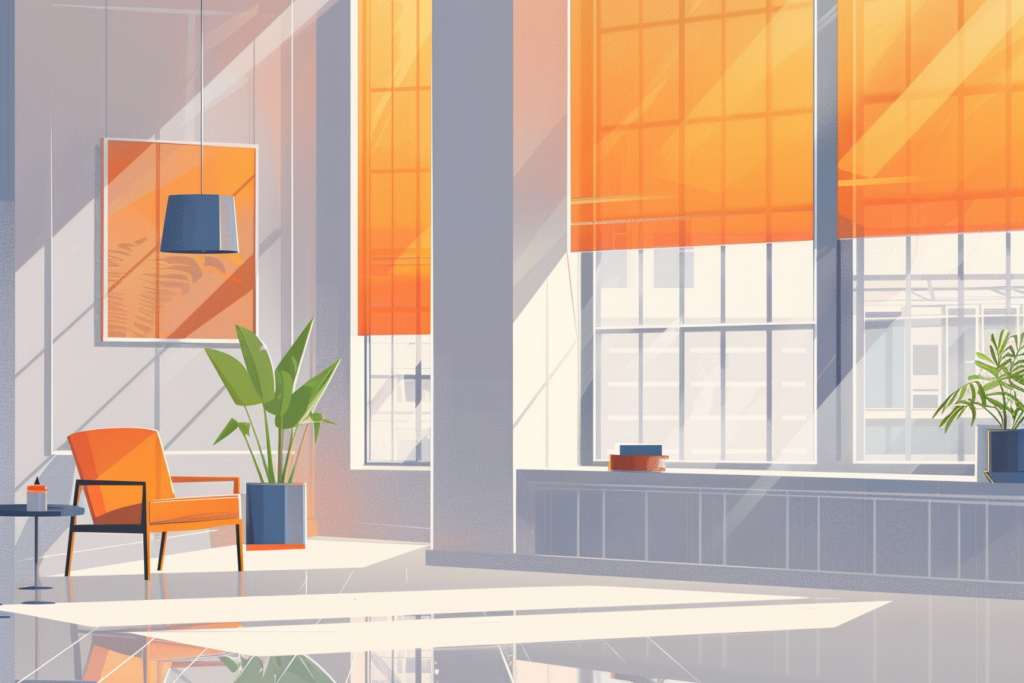Summer brings long days, abundant sunshine, and, unfortunately, soaring temperatures. Keeping your home cool during this season is crucial, and windows play a significant role in either retaining or repelling heat.
We will explore various methods to keep windows cool in the summer, examining their effectiveness, ease of implementation, cost, and impact on energy efficiency. From traditional solutions like curtains and blinds to modern technologies such as reflective films and smart glass, this guide provides a comprehensive overview to help you make informed decisions.
1. Curtains and Blinds

While installing curtains and blinds might seem a bit obvious, they can do wonders for keeping the heat out during the long summer months.
Curtains and blinds are a classic solution for keeping windows cool. Heavy blackout curtains can block out a significant amount of sunlight, reducing heat gain. Similarly, blinds, especially those with reflective surfaces, can deflect sunlight away from windows, keeping the interior cooler.
Installing curtains or blinds is straightforward and can be done with basic tools. Many homeowners can install them without professional help.
Cost: The cost varies widely depending on the material and style. Basic blinds and curtains are affordable, but designer options or custom fittings can be more expensive.
Impact on Energy Efficiency: By blocking direct sunlight, curtains and blinds can reduce the need for air conditioning, thereby lowering energy bills. However, they also darken rooms, potentially increasing the need for artificial lighting.
2. Reflective Window Films
Reflective window films are a modern solution designed to reduce heat gain by reflecting sunlight. These films are known to block up to 99% of UV rays, significantly reducing indoor temperatures.
Applying reflective films requires precision and patience. While it is possible to do it yourself, professional installation ensures a bubble-free finish and optimal performance.
Cost: Reflective films are relatively inexpensive, with DIY kits available for those looking to save on professional installation costs.
Impact on Energy Efficiency: Reflective films can substantially lower cooling costs by reducing heat gain. Additionally, they protect furniture and flooring from UV damage, extending their lifespan.
3. Solar Shades
Solar shades, sometimes called solar screens, are designed to block and reflect sunlight while still allowing visibility. They reduce glare and heat without completely darkening the room.
Solar shades can be installed similarly to regular blinds or shades. DIY installation is possible, though professional installation ensures proper fitting.
Cost: The cost of solar shades varies based on size, quality, and brand. They are generally more expensive than traditional blinds but offer additional benefits in terms of heat reduction and visibility.
Impact on Energy Efficiency: Solar shades can reduce your energy bills by blocking a generous amount of solar heat. Their ability to allow natural light while reducing glare can also decrease the need for artificial lighting.
4. External Shutters and Awnings
External shutters and awnings provide an additional layer of protection by blocking sunlight before it even reaches the window. This method is highly effective in reducing heat gain.
Installing external shutters or awnings can be more complex and may require professional assistance, especially for custom or motorized options.
Cost: The cost varies widely depending on the material, design, and whether motorization is involved. They are generally more expensive than internal solutions but offer superior heat reduction.
Impact on Energy Efficiency: By blocking sunlight externally, shutters and awnings can greatly reduce indoor temperatures and cooling costs. Additionally, they offer protection against weather elements and enhance curb appeal.
5. Smart Glass
Smart glass, or electrochromic glass, can change its light transmission properties when voltage is applied. This high-tech solution allows windows to switch from clear to tinted, effectively controlling heat gain and glare.
Installing smart glass is a complex process that requires professional installation. It is often used in new constructions or major renovations.
Cost: Smart glass is definitely more expensive than other window cooling solutions due to its advanced technology and installation requirements.
Impact on Energy Efficiency: Smart glass offers excellent energy efficiency by dynamically controlling the amount of sunlight entering a room. It can greatly reduce cooling costs and improve comfort, though the high initial investment may be a deterrent.
6. Window Insulation
Window insulation methods, such as caulking and weatherstripping, help seal gaps around windows, preventing hot air from entering and cool air from escaping. Insulating window films can also add an extra layer of protection against heat.
Caulking and weatherstripping are relatively simple DIY tasks. Insulating films can also be applied without professional help, though precision is required.
Cost: These methods are generally inexpensive, making them accessible for most homeowners. Weatherstripping and caulking materials are particularly affordable.
Impact on Energy Efficiency: Insulation methods can significantly reduce cooling costs by improving the overall thermal performance of windows. They also enhance comfort by preventing drafts and maintaining a stable indoor temperature.
7. Landscaping
Strategically placed trees, shrubs, and vines can provide natural shade for windows, reducing heat gain. Deciduous trees are particularly effective, offering shade in the summer while also permitting sunlight through in the winter when their leaves have fallen.
Planting trees and shrubs is a straightforward process, though it requires time and patience for plants to grow to a size that provides significant shade.
Cost: The cost of landscaping varies depending on the type and size of plants. While initial costs can be moderate, maintenance expenses should also be considered.
Impact on Energy Efficiency: Landscaping is a long-term investment that can significantly reduce cooling costs by providing natural shade. It also enhances the aesthetic appeal and value of a property.
Keeping Cool This Summer
Keeping windows cool in the summer is vital for staying comfy during the blistering hot summer days while also reducing energy costs. The methods discussed in this review, from traditional curtains and blinds to advanced smart glass technology, offer various solutions to suit different needs and budgets. Each method has its own set of advantages and considerations, making it important to assess your specific situation and goals before deciding.
Curtains and blinds are simple and cost-effective, while reflective films and solar shades offer modern solutions with added benefits. External shutters and awnings provide superior heat reduction but come at a higher cost. Smart glass represents the pinnacle of window cooling technology, offering dynamic control over heat and light, albeit at a premium price. Insulation methods and landscaping provide additional ways to enhance window performance and overall home energy efficiency.
By combining several different strategies, you can create a comprehensive approach to keeping your windows cool and your home comfortable throughout the summer months.
You might also be interested in: A Guide To Seasonal Home Maintenance For All Homeowners




